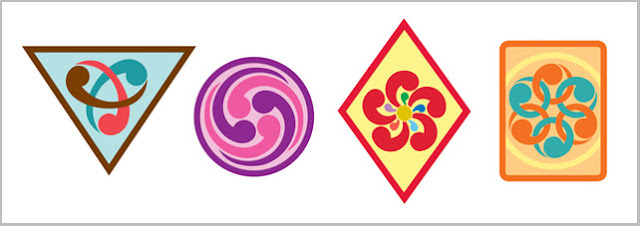Girl Scouts in unveiling some new innovation badges in an effort to grow the new era of female workers for the brave new word on innovation and the technology needs of the future. Here is Fast Comapny's article about it!
What Designing The New Girls Scout
Innovation Badges Taught Us About Raising Leaders
As part of the
organization's rebranding, the Girl Scouts has introduced an innovation
component. In designing the program, Jump Associates developed some tips for
training girls to become future leaders.
As the Girl Scouts approach their 100-year anniversary in
March, they are introducing a whole new lineup of badges. Way back in 1913, the
organization had badges like Flyer and Electrician to represent those
trailblazing professions. Today, girls live in vastly different times and have
wider opportunities in business leadership. With that in mind, Jump worked with
the Girl Scouts to develop a badge program to expose girls to cutting-edge
fields such as web design and social innovation.
In thinking about what we’ll need from our future leaders,
executives have come to realize that the ability to innovate will be one of the
foremost qualities--that is, the ability to quickly identify solutions for
problems, many of which don’t even exist yet. To paraphrase President Barack
Obama: Innovation is our ticket to success in the future. But in the U.S.,
women are still poorly represented in leadership teams. At last count, there
were just 12 women CEOs in Fortune 500 companies. In addition, while technology
is fueling a lot of new business growth, it’s an industry still maligned with
very low numbers of women.
[The badges for Cadettes, Juniors, Brownies, and Seniors]
When we started to design the program, we realized that it
would need to be much more than about designing cool stuff; it would have to
involve developing empathy. It would also have to be age appropriate across
four age levels, from second to tenth grade. The program caters to younger
girls’ interests and capabilities, yet grows as older girls develop more
critical-thinking skills. For this reason, the first level of Innovation, the
Inventor badge, is about creating new things, while senior Girl Scouts work on
building new businesses for the Social Innovator badge.
To better understand the full value Girl Scouts has had on
women, and to learn what girls need today, Jump spent time talking with Girl
Scouts alumnae (of which there are over 50 million today), current Girl Scouts
of all ages and their parents, and executives within the organization.
Our findings led to some core principles that guided the
definition and development of the Innovation badges. These principles are
relevant for anyone developing ideas and businesses, not just children and
young adults.
1.
Leverage children’s existing creativity
Children are naturally curious and creative. The last thing
one would want to do is stifle those tendencies by prescribing one path toward
innovation. At the same time, there are best practices that the girls can
benefit from learning. The trick in creating the Innovation badge curriculum
was to strike a good balance between providing suggestions and letting the
girls’ inner interests guide them. Rather than dictating the right way to
develop new ideas and businesses, the Innovation badges let the girls choose
among three options at each step, encouraging them to work on something they’re
passionate about. This way, they can customize their own program to match their
unique interests and style.
2.
Train hybrid thinkers
Solving the ambiguous problems that plague our society, such
as health care or access to clean water, will require working across multiple
disciplines. Instilling the value of hybrid thinking--the mashing up of
disparate disciplines--will ensure that we have leaders ready to tackle
pressing issues. The Innovation badge program incorporates methods from many
fields--such as anthropology, engineering, graphic design, and business
strategy--to help the girls identify what’s needed, imagine what’s possible,
and see how to make ideas a reality.
3.
Build empathy before solutions
Making the world a better place for those who inhabit it is
not about creating cool, shiny new objects. To have real impact on the world,
to make the world a better place--the heart of the Girl Scout ethos--the girls
should be able to identify what people really need. Each of the four levels of
the Innovation badge has activities to help the girls gain empathy for the
people for whom they’re designing solutions. To this end, the girls are
trained, for example, to observe, take notes, and experience things first hand.
4.
Enable great storytellers
One of the oft-overlooked softer skills that can decide
whether an idea becomes a reality is good storytelling. Many great ideas never
see the light of day because the creators neglected to craft compelling
stories--no one ever got the full potential of the idea. The Innovation badge
program builds good storytelling skills by instructing the girls on how to
pitch an idea through a variety of means, from giving a presentation to using
advertisement or even putting on a skit.
5.
Get feedback early and often
Creating great products and services requires getting good
feedback along the way. The Girl Scouts Innovation program reinforces the
importance of asking people for feedback through a variety of means. The
program also underscores the value of collaborating with friends and family
members to make ideas better. As the world gets increasingly more complex,
future leaders will have to be experts at enlisting others to help create
solutions.
Given how complex and uncertain that future is sure to be,
it’s assuring to have organizations like the Girl Scouts focusing on building
the skills our future leaders will surely need. With the Innovation badge and
the rest of the new badge lineup, the Girl Scouts are well positioned to
develop the leaders of tomorrow.
Lauren Pollak leads Jump's New York office. She advises business
leaders in industrial materials, packaged food, financial services, and retail
on achieving their growth objectives. She has taught new productdevelopment as
an adjunct professor at the George Washington University School of Business and
served on the Innovation Advisory Board for the American Society of Mechanical
Engineers. Lauren has published several articles on managing innovation and
fostering a culture of exploration and has pioneered Jump's innovation
methodology. She has a background in physics and engineering. Prior to Jump,
she applied this knowledge to create innovative science education programs for
high school students.



